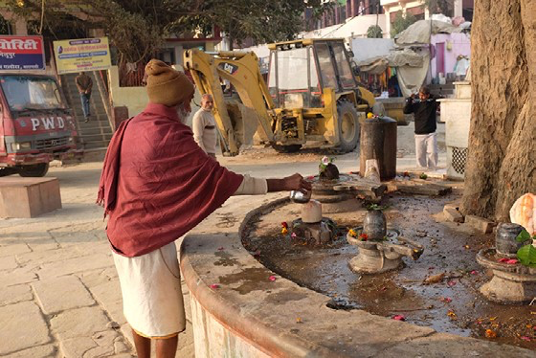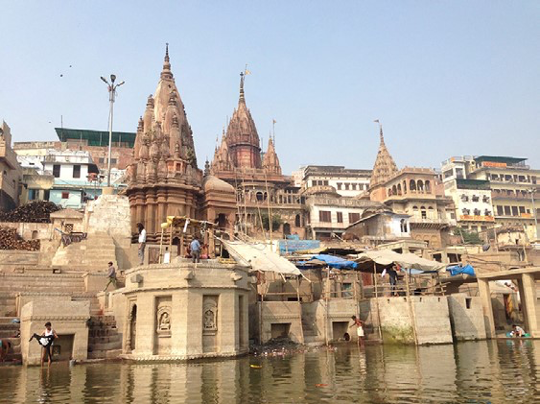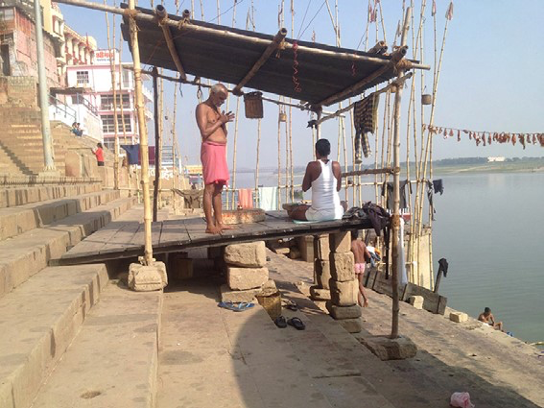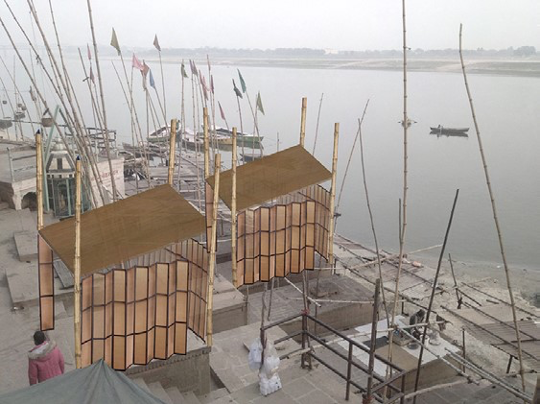Amita Sinha
University of Illinois at Urbana Champaign
Sinha2@illinois.edu
The ghats (steps and landings) on the Ganga River in Varanasi, India are a vernacular landscape defined by situated events, natural—flooding and changing flow of the Ganga–and cultural including ritual activities and performances that sustain public life. The paper describes and interprets cultural events—the diurnal and seasonal spatial practices tied to the movement of sun, moon, and the Ganga—as intangible cultural heritage, and suggests a new approach for their conservation.
The ghats are a threshold to both the city and the Ganga. Here one prepares to enter into the Ganga, find one’s way to the great temples of Varanasi, to embark on the passage from death to the beyond, and to be liberated from the cycle of births. Here activities associated with private life—death, worship, bodily functions– are on public display. The ghats are a liminal space between the holy river and sacred land where the eruption of the sacred in the profane creates meaningful pauses in everyday life. Here pilgrims engage in rites of passage, aghori ascetics in subversive practices, and tourists in stepping outside their cultural frame of reference in a quest for spirituality, creating a ‘third space’ (Bhabha 1994).
The landscape is inscribed by place making actions of the faithful that affirm the sacred (Figure 1). Around and in-between the many sacred shrines, everyday life swirls, as commerce, recreation, and craft making occur in spatial practices of multiple communities. Spatial practices ‘structure the determining conditions of social life’ (de Certeau 1984, 96) and articulate the design language of the ghats. Places are found, built, and appropriated, for worship, play, commerce, and community, making the landscape not just a view but also a situated event. This dynamic landscape structured by natural and cultural events and crafted by traditional practices is of immense heritage value and requires a new conservation approach based upon place-making.
The structures on the ghats are made by crafting building form, i.e. working with hands, material consciousness, using skills grounded in physical practice, and drawing upon collective shared knowledge (Sennett 2008). Two principles are discerned in interpreting the design grammar of ghats—shared vocabulary between historic buildings and steps and landings, and jugaad, (improvised or make-do) implying to innovate with limited resources. The monumental temples and palaces on the riverfront give it a majestic and imposing skyline while the small shrines and alcoves below on the landings are unobtrusive until one stumbles upon them (Figure 2). Although differing in scale, they use the same architectural prototypes. The alcove on the temple exterior climbs down to the ghats housing lingas, Ganga, and other gods and goddesses. They interrupt the linearity of steps, creating volumes and pauses. They occur in profusion on the river’s edge in Kedar, Manikarnika, and Panchganga Ghats where they are square or octagonal, hollow or solid. Some hollow cubes contain lingas, others are meant for yogis to meditate. They conform to the image of Ganga washing over the head of Shiva as a seated yogi or a linga, celebrated in temple interiors (Figure 3).
The historic buildings are fort-like, solid and closed below for protection from flooding Ganga and open at the top for views and breezes. In contrast the shops and site furniture are human scale, appear to be temporary and built with found materials. They are examples of jugaad, a way of thinking and acting in everyday life in response to challenges and overcoming them ingeniously (Radjou, Prabhu, and Ahuja 2012). The historic and vernacular illustrate the contrasting static and kinetic city (Mehrotra 2008). Kinetic urbanism is always in flux, occupies interstitial spaces between monuments, where marginalized communities participate in the informal urban economy. While the static city is associated with architectural monuments, the kinetic city is a temporal articulation and occupation of space.
Public life in the ghats is sustained by multiple communities—of ghatiyas (ritual priests), boatmen, aghoris, barbers, washermen, vendors, backpacker tourists, pilgrim groups, students, mourners, among others. Some are actively engaged in worship, making folk-art, crafting objects, and selling wares; others observe, and participate in casual social encounters and mesmerizing spectacles. Religious, commercial, and recreational activities occur in close proximity and structures and spaces have multiple functions. Space is generated in behavior settings established in small groups of pilgrims, visitors, students, and boatmen, sitting on platforms, and on steps and landings, talking, playing cards, singing, listening to discourses, and eating. Boats are made and repaired by boatmen as are umbrellas and smaller craft items such as flower garlands and leaf vessels. Food is prepared over small stoves as is tea, a popular drink on the ghats. The recurring patterns of behavior and milieu reveal a close fit or synomorphy (Barker 1968). The octagonal form of platforms is especially conducive to groups in a circle; the linearity of steps favors the display of artwork and people watching. The boundaries of the social group and setting coincide in production of space in place practiced.
Places are made using found materials–bamboo frames are erected over alcoves on the ghat edges, wooden platforms are supported by bricks and shaded by jute cloth stretched over bamboo poles, a metallic railing is installed around a linga and covered with tin shade. Shade from the incessant sun is achieved in creative ways—lean to against the wall, cloth/burlap strung over ropes stretched between bamboo poles for astrologers and tea shops (Figure 4). Shelter is ingeniously made using minimal resources through jugaad. Surfaces become canvases for public art by local artists who paint mythological figures, sacred symbols, and natural forms.
It is widely acknowledged that Varanasi Ghats embody cultural heritage but less understood are the various ways in its material and intangible forms are intertwined. Historic monuments built in the last three centuries are the focus of current preservation efforts, although most are in private use, and do not contribute to the public realm. The steps, landings, and their structures as an enacted landscape of a rich and vibrant public life, have been ignored so far (Dar 2005). This vernacular landscape is shaped by spatial practices that keep ancient traditions alive and vigorous. It is always in flux, its temporality a function of the Ganga’s seasonal flow and the rhythm of rituals and festivals determined by planetary motion. The kinetic aspect necessitates rethinking the existing monument-centric preservation practice (Sinha 2017).
The scope of conservation should expand to include managing public spaces of the ghats so that they are not encroached by private interests, regulating practices that pollute the Ganga, and promoting arts and crafts.1 New structures should be based upon the traditional design grammar;
1 In two week long site workshops in Varanasi (January 2014 and 2016) conducted with B.N. College of
Architecture, Pune, India, the ghats were studied extensively by undergraduate and graduate students in
Landscape Architecture and Architecture. The proposals are drawn from two project reports Ghats of
Varanasi on the Ganga in India: The Cultural Landscape Reclaimed and Envisioning a Resilient Cultural
Landscape: Ghats on the Ganga, Varanasi, India summarizing design studio work at University of Illinois at
Urbana Champaign, USA campus (Spring 2014 and 2016). The projects were partially supported by
instead of being fixed and rigid, they should be deployable so that they can adapt to kinetic urbanism. Local crafts such as bamboo umbrellas, wooden boats, clay pottery, and making candle wick and flower garlands should be promoted and incentivized through subsidies. Cultural events such as Subh-e-Banaras and evening aartis at many ghats should be supplemented with organized exhibitions of arts and crafts, and music and dance festivals celebrating the Banaras Gharana (school). More specifically the historic monuments should be integrated into the public realm; visual aids should be designed for way-finding; narrative surfaces should be designated for folk-art; and deployable structures should be built for vending kiosks and visitor facilities (Figure 5).

Figure 1. Worship of linga on a tree platform in Assi Ghat

Figure 2. Aedicule on Assi Ghat
Wadsworth Endowment to the Department of Landscape Architecture. The reports can be accessed at: http://landarch.illinois.edu/india-projects.

Figure 3. Alcoves in Manikarnika Ghat

Figure 4. Shade structures on Panchganga Ghat

Figure 5. Deployable changing rooms on Panchganga Ghat
References
Homi Bhabha. The Location of Culture (New York: Routledge, 1994).
Roger Barker. Ecological Psychology: Concepts and Methods for Studying the Environment of Human Behavior (Palo, Alto: Stanford University Press, 1968).
Michel de Certeau,. The Practice of Everyday Life (Berkeley and Los Angeles: University of California Press, 1984).
Vrinda Dar, “ Threats and Prospects”, in George Michell and Rana P. B. Singh (eds.) Banaras The City Revealed. Marg Publications, 57(2), December 2005, 139-143.
Rahul Mehrotra, “Negotiating the Static and Kinetic Cities: The Emergent Urbanism of Mumbai”, in Andreas Huyssen (ed.) Other Cities, Other Worlds: Urban Imaginaries in a Globalizing Age (Durham, North Carolina: Duke University Press, 2008), 205-218.
Navi Radjou, Jaideep Prabhu, and Simone Ahuja. Jugaad Innovation: Think Frugal, Be Flexible, Generate Breakthrough Growth (San Francisco: Jossey-Bass), 2012.
Richard Sennett. The Craftsman (New Haven: Yale University Press, 2008).
Amita Sinha, “Introduction”, Silva, Kapila and Amita Sinha (eds.) Cultural Landscapes of South Asia: Studies in Heritage Conservation and Management (New York, Routledge, 2017), pp. 1-10.



